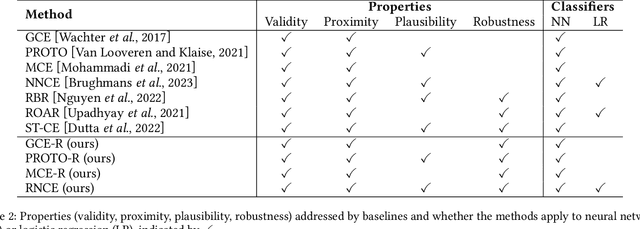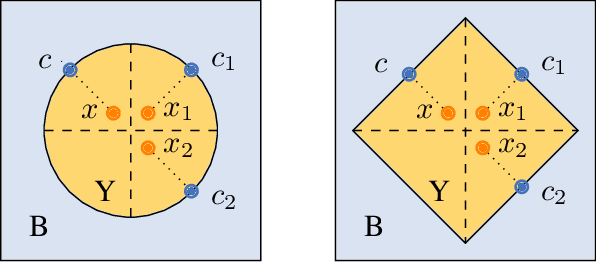Francesco Leofante
Synthesising Counterfactual Explanations via Label-Conditional Gaussian Mixture Variational Autoencoders
Oct 06, 2025Abstract:Counterfactual explanations (CEs) provide recourse recommendations for individuals affected by algorithmic decisions. A key challenge is generating CEs that are robust against various perturbation types (e.g. input and model perturbations) while simultaneously satisfying other desirable properties. These include plausibility, ensuring CEs reside on the data manifold, and diversity, providing multiple distinct recourse options for single inputs. Existing methods, however, mostly struggle to address these multifaceted requirements in a unified, model-agnostic manner. We address these limitations by proposing a novel generative framework. First, we introduce the Label-conditional Gaussian Mixture Variational Autoencoder (L-GMVAE), a model trained to learn a structured latent space where each class label is represented by a set of Gaussian components with diverse, prototypical centroids. Building on this, we present LAPACE (LAtent PAth Counterfactual Explanations), a model-agnostic algorithm that synthesises entire paths of CE points by interpolating from inputs' latent representations to those learned latent centroids. This approach inherently ensures robustness to input changes, as all paths for a given target class converge to the same fixed centroids. Furthermore, the generated paths provide a spectrum of recourse options, allowing users to navigate the trade-off between proximity and plausibility while also encouraging robustness against model changes. In addition, user-specified actionability constraints can also be easily incorporated via lightweight gradient optimisation through the L-GMVAE's decoder. Comprehensive experiments show that LAPACE is computationally efficient and achieves competitive performance across eight quantitative metrics.
Counterfactual Scenarios for Automated Planning
Aug 29, 2025Abstract:Counterfactual Explanations (CEs) are a powerful technique used to explain Machine Learning models by showing how the input to a model should be minimally changed for the model to produce a different output. Similar proposals have been made in the context of Automated Planning, where CEs have been characterised in terms of minimal modifications to an existing plan that would result in the satisfaction of a different goal. While such explanations may help diagnose faults and reason about the characteristics of a plan, they fail to capture higher-level properties of the problem being solved. To address this limitation, we propose a novel explanation paradigm that is based on counterfactual scenarios. In particular, given a planning problem $P$ and an \ltlf formula $\psi$ defining desired properties of a plan, counterfactual scenarios identify minimal modifications to $P$ such that it admits plans that comply with $\psi$. In this paper, we present two qualitative instantiations of counterfactual scenarios based on an explicit quantification over plans that must satisfy $\psi$. We then characterise the computational complexity of generating such counterfactual scenarios when different types of changes are allowed on $P$. We show that producing counterfactual scenarios is often only as expensive as computing a plan for $P$, thus demonstrating the practical viability of our proposal and ultimately providing a framework to construct practical algorithms in this area.
Counterfactual Strategies for Markov Decision Processes
May 14, 2025Abstract:Counterfactuals are widely used in AI to explain how minimal changes to a model's input can lead to a different output. However, established methods for computing counterfactuals typically focus on one-step decision-making, and are not directly applicable to sequential decision-making tasks. This paper fills this gap by introducing counterfactual strategies for Markov Decision Processes (MDPs). During MDP execution, a strategy decides which of the enabled actions (with known probabilistic effects) to execute next. Given an initial strategy that reaches an undesired outcome with a probability above some limit, we identify minimal changes to the initial strategy to reduce that probability below the limit. We encode such counterfactual strategies as solutions to non-linear optimization problems, and further extend our encoding to synthesize diverse counterfactual strategies. We evaluate our approach on four real-world datasets and demonstrate its practical viability in sophisticated sequential decision-making tasks.
RobustX: Robust Counterfactual Explanations Made Easy
Feb 19, 2025Abstract:The increasing use of Machine Learning (ML) models to aid decision-making in high-stakes industries demands explainability to facilitate trust. Counterfactual Explanations (CEs) are ideally suited for this, as they can offer insights into the predictions of an ML model by illustrating how changes in its input data may lead to different outcomes. However, for CEs to realise their explanatory potential, significant challenges remain in ensuring their robustness under slight changes in the scenario being explained. Despite the widespread recognition of CEs' robustness as a fundamental requirement, a lack of standardised tools and benchmarks hinders a comprehensive and effective comparison of robust CE generation methods. In this paper, we introduce RobustX, an open-source Python library implementing a collection of CE generation and evaluation methods, with a focus on the robustness property. RobustX provides interfaces to several existing methods from the literature, enabling streamlined access to state-of-the-art techniques. The library is also easily extensible, allowing fast prototyping of novel robust CE generation and evaluation methods.
Rigorous Probabilistic Guarantees for Robust Counterfactual Explanations
Jul 10, 2024Abstract:We study the problem of assessing the robustness of counterfactual explanations for deep learning models. We focus on $\textit{plausible model shifts}$ altering model parameters and propose a novel framework to reason about the robustness property in this setting. To motivate our solution, we begin by showing for the first time that computing the robustness of counterfactuals with respect to plausible model shifts is NP-complete. As this (practically) rules out the existence of scalable algorithms for exactly computing robustness, we propose a novel probabilistic approach which is able to provide tight estimates of robustness with strong guarantees while preserving scalability. Remarkably, and differently from existing solutions targeting plausible model shifts, our approach does not impose requirements on the network to be analyzed, thus enabling robustness analysis on a wider range of architectures. Experiments on four binary classification datasets indicate that our method improves the state of the art in generating robust explanations, outperforming existing methods on a range of metrics.
Contestable AI needs Computational Argumentation
May 17, 2024
Abstract:AI has become pervasive in recent years, but state-of-the-art approaches predominantly neglect the need for AI systems to be contestable. Instead, contestability is advocated by AI guidelines (e.g. by the OECD) and regulation of automated decision-making (e.g. GDPR). In this position paper we explore how contestability can be achieved computationally in and for AI. We argue that contestable AI requires dynamic (human-machine and/or machine-machine) explainability and decision-making processes, whereby machines can (i) interact with humans and/or other machines to progressively explain their outputs and/or their reasoning as well as assess grounds for contestation provided by these humans and/or other machines, and (ii) revise their decision-making processes to redress any issues successfully raised during contestation. Given that much of the current AI landscape is tailored to static AIs, the need to accommodate contestability will require a radical rethinking, that, we argue, computational argumentation is ideally suited to support.
Interval Abstractions for Robust Counterfactual Explanations
Apr 21, 2024



Abstract:Counterfactual Explanations (CEs) have emerged as a major paradigm in explainable AI research, providing recourse recommendations for users affected by the decisions of machine learning models. However, when slight changes occur in the parameters of the underlying model, CEs found by existing methods often become invalid for the updated models. The literature lacks a way to certify deterministic robustness guarantees for CEs under model changes, in that existing methods to improve CEs' robustness are heuristic, and the robustness performances are evaluated empirically using only a limited number of retrained models. To bridge this gap, we propose a novel interval abstraction technique for parametric machine learning models, which allows us to obtain provable robustness guarantees of CEs under the possibly infinite set of plausible model changes $\Delta$. We formalise our robustness notion as the $\Delta$-robustness for CEs, in both binary and multi-class classification settings. We formulate procedures to verify $\Delta$-robustness based on Mixed Integer Linear Programming, using which we further propose two algorithms to generate CEs that are $\Delta$-robust. In an extensive empirical study, we demonstrate how our approach can be used in practice by discussing two strategies for determining the appropriate hyperparameter in our method, and we quantitatively benchmark the CEs generated by eleven methods, highlighting the effectiveness of our algorithms in finding robust CEs.
Robust Counterfactual Explanations in Machine Learning: A Survey
Feb 02, 2024
Abstract:Counterfactual explanations (CEs) are advocated as being ideally suited to providing algorithmic recourse for subjects affected by the predictions of machine learning models. While CEs can be beneficial to affected individuals, recent work has exposed severe issues related to the robustness of state-of-the-art methods for obtaining CEs. Since a lack of robustness may compromise the validity of CEs, techniques to mitigate this risk are in order. In this survey, we review works in the rapidly growing area of robust CEs and perform an in-depth analysis of the forms of robustness they consider. We also discuss existing solutions and their limitations, providing a solid foundation for future developments.
Recourse under Model Multiplicity via Argumentative Ensembling (Technical Report)
Jan 03, 2024Abstract:Model Multiplicity (MM) arises when multiple, equally performing machine learning models can be trained to solve the same prediction task. Recent studies show that models obtained under MM may produce inconsistent predictions for the same input. When this occurs, it becomes challenging to provide counterfactual explanations (CEs), a common means for offering recourse recommendations to individuals negatively affected by models' predictions. In this paper, we formalise this problem, which we name recourse-aware ensembling, and identify several desirable properties which methods for solving it should satisfy. We show that existing ensembling methods, naturally extended in different ways to provide CEs, fail to satisfy these properties. We then introduce argumentative ensembling, deploying computational argumentation to guarantee robustness of CEs to MM, while also accommodating customisable user preferences. We show theoretically and experimentally that argumentative ensembling satisfies properties which the existing methods lack, and that the trade-offs are minimal wrt accuracy.
Promoting Counterfactual Robustness through Diversity
Dec 12, 2023



Abstract:Counterfactual explanations shed light on the decisions of black-box models by explaining how an input can be altered to obtain a favourable decision from the model (e.g., when a loan application has been rejected). However, as noted recently, counterfactual explainers may lack robustness in the sense that a minor change in the input can cause a major change in the explanation. This can cause confusion on the user side and open the door for adversarial attacks. In this paper, we study some sources of non-robustness. While there are fundamental reasons for why an explainer that returns a single counterfactual cannot be robust in all instances, we show that some interesting robustness guarantees can be given by reporting multiple rather than a single counterfactual. Unfortunately, the number of counterfactuals that need to be reported for the theoretical guarantees to hold can be prohibitively large. We therefore propose an approximation algorithm that uses a diversity criterion to select a feasible number of most relevant explanations and study its robustness empirically. Our experiments indicate that our method improves the state-of-the-art in generating robust explanations, while maintaining other desirable properties and providing competitive computational performance.
 Add to Chrome
Add to Chrome Add to Firefox
Add to Firefox Add to Edge
Add to Edge